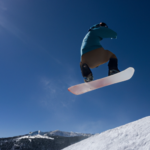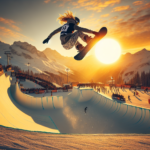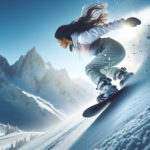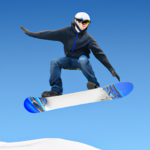Kick start your snowboarding adventure by getting to grips with one of the sport’s most iconic features: the halfpipe. This thrilling terrain, deeply entrenched in the heart of snowboarding culture, is a pulse-raising engineering marvel shaped from snow—with high walls and a flat-bottomed center—offering thrilling opportunities for tricks and heights. This aptly named feature, resembling half of a giant pipe, is fundamentally a platform for gravity-defying stunts and aerobatics you’ll come to know and love in your snowboarding journey. As we delve into the details about the evolution, construction, and riding techniques of the halfpipe, you will become a well-rounded snowboarding enthusiast, groomed to take your place among the sport’s ever-growing fanbase.
Definition of a Halfpipe in Snowboarding
Brief Description
In the realm of snowboarding, a halfpipe takes the spotlight as one of the main features. Picture a semi-circular trench or ramp that spans up to several hundred feet, its sides towering like two snow walls. What makes it practically a magnet for snowboarders is the chance to perform intricate tricks and maneuvers as they swerve and slide from one side to the other.
Historical Background
The halfpipe’s influence in snowboarding dates back to the 1970s and 1980s when it first made its mark in the fields of skateboarding and BMX biking. Its incorporation into snowboarding offered a new platform to exhibit grace, athleticism, and skill. The first halfpipes were crude and lacked the finesse of the structures seen today, but they laid the groundwork for what would become a significant aspect of the sport.
Etymology of the Term
The term ‘Halfpipe’ seems pretty straightforward and easy to decipher. It hints at the structure’s design as it resembles one-half of a full pipe or tube. Though the actual construction deviates slightly, the name has stuck and continues to represent this snowboarding sensation.
Design and Construction of a Halfpipe
Standard Dimensions of a Halfpipe
The typical halfpipe in snowboarding is no small structure. It often reaches lengths of around 150 to 160 meters and widths between 15 to 23 meters. The walls on both sides can tower upwards from 5 meters to 7 meters, allowing for dramatic upward thrusts and gravity-defying tricks.
Material Used in Construction
Snow is the main building block of a halfpipe, often packed and shaped into the desired dimensions. It requires a specific type of snow, one that is dry enough to hold its shape but wet enough to freeze and provide a stable platform. Also, a layer of ice is necessary to facilitate smooth, fast movement.
Process of Construction
Constructing a halfpipe isn’t a task left to amateurs. It requires professionals armed with heavy machinery to carve and groom the snow. Nowadays, a machine called a pipe dragon is often utilized to get the precise semi-circular shape that a top-notch halfpipe requires.
Halfpipe Safety Considerations
Importance of an Effective Safety Gear
While thrilling, halfpipe snowboarding doesn’t come without its risks, which makes safety gear a non-negotiable equipment. This includes a helmet to protect your head from potential falls and impacts, goggles to safeguard your eyes from the snow and glare, and padding on your knees, elbows, and even your backside to soften any blows.
Risk Factors
Halfpipe snowboarding isn’t immune to risks. From a high risk of injuries due to falls or crashes, exposure to cold weather conditions, and the constant threat of avalanches in certain areas, safety should always be your top priority.
How to Minimize Incidences of Accidents
You can reduce the risk of accidents by ensuring you are physically fit, adequately trained, and well-equipped with safety gear. Always assess the conditions of the halfpipe and the weather before you begin. Remember, practice and caution make for a better experience!
The Role of a Halfpipe in Snowboarding Competitions
Influence on the Sport’s Popularity
Halfpipes have played a tremendous role in boosting snowboarding’s popularity. Their introduction brought a new wave of thrill and competition, attracting not only seasoned snowboarders but also new enthusiasts eager to master the halfpipe.
Impact on Scoring and Judging
In competitive snowboarding, halfpipe events are scored based on a variety of factors. Judges often look at the height of the jumps, the complexity, and execution of tricks, the control and fluidity of movements, and the overall impression. Thus, the halfpipe’s design and condition can significantly impact a competition’s outcome.
Top Snowboarding Competitions Involving a Halfpipe
Over the years, several snowboarding competitions have marked their relevance in the sporting world. These include the Winter X Games and Olympics, famed for their halfpipe events. Other noteworthy mentions are the Burton US Open and FIS Snowboarding World Cup that also play host to spectacular halfpipe performances.
Famous Halfpipes Globally
The Superpipe in Colorado
When talking about globally renowned halfpipes, the Superpipe at the Buttermilk Mountain in Colorado is a common mention. It is an Olympic-sized structure that has seen multiple thrilling escapades over the years.
The Eagle Superpipe in Utah
The Eagle Superpipe in Park City Mountain, Utah, boasts of being one of the largest halfpipes in North America, regularly hosting high-level competitions.
Laax in Switzerland
On the European side, you have Laax in Switzerland. Considered among the best in the world, this halfpipe spot draws visitors from all corners, eager to test their skills and take in the stunning views.
Calgary Olympic Park in Canada
In the north, the Calgary Olympic Park in Canada has earned its reputation due to its well-maintained halfpipe and the quality of events it hosts, contributing to the global appeal of halfpipe snowboarding.
Iconic Snowboarders in Halfpipe
Shaun White
Throughout its history, halfpipe snowboarding has witnessed many notable figures, but Shaun White arguably stands out as one of the most influential riders. His extraordinary style, unmatched control, and commitment to push the boundaries have stamped his name in halfpipe snowboarding folklore.
Chloe Kim
Chloe Kim is a powerhouse in women’s halfpipe snowboarding. Despite her young age, she has dominated competitions worldwide, her memorable performances on the halfpipe making her a role model for many aspiring snowboarders.
Hannah Teter
Hannah Teter has been a significant influence, especially with her focus on promoting positive social change through sport. Her accomplishments and worldwide recognition have indeed made her a figure to emulate.
Danny Davis
In the men’s division, Danny Davis is recognized for his unique style and frequent contribution towards the evolution of the sport, making him a significant player in halfpipe snowboarding.
Types of Tricks and Skills in Halfpipe Snowboarding
Basic Halfpipe Techniques
In halfpipe snowboarding, beginners usually start with simple maneuvers like fakies, where you ride the halfpipe backwards, or board grabs, where you hold onto your board mid-jump.
Intermediate to Advanced Skills
As you progress, you can venture into more complex tricks. There’s the Alley Oop, where riders rotate in the direction opposite to their travel. Or the Air to Fakie, a dramatic trick that has riders launching high into the air and landing to continue their run backwards!
Iconic Tricks in Competition
At the competition level, riders often pull off incredible tricks that leave audiences awestruck. From the McTwist, performed by doing a one-and-a-half flip with a 540-degree turn, to the Double Cork, where riders perform off-axis twists, these iconic tricks always turn heads!
Training for Halfpipe Snowboarding
The Role of Physical Fitness
Training for halfpipe snowboarding demands a high level of physical fitness. Upper body strength, well-toned core muscles, and excellent cardiovascular endurance are necessary to task the rigors of this sport.
Types of Training
Training can range from on-field practice to gym workouts focusing on strength, flexibility, and balance. Other forms include cardio exercises like swimming and running, and sports like skateboarding and surfing that improve balance and coordination.
Importance of Coaching
Coaches play a vital role in halfpipe snowboarding, imparting techniques, ensuring safety, and improving performance. Their experience and knowledge can provide crucial guidance, especially for those aspiring to compete.
The Evolution of Halfpipe Snowboarding
Innovation in Design and Construction
Over time, halfpipe snowboarding has seen significant changes. One of the most obvious has been in the design and construction of the halfpipes themselves. From crude, hand-built structures, the halfpipes of today are precision-engineered marvels, with smoother curves, bigger walls, and more consistent surfaces.
Advancement in Skills and Techniques
The sport has also witnessed an evolution in the skills and techniques displayed by riders. Today’s snowboarders are performing tricks which were once unimaginable. They’re pushing boundaries and reinventing what’s possible on a halfpipe!
Changes in Rules and Judging Criteria
Just as the sport has progressed, so too has the competition. Judging criteria have become more rigorous and detailed, focusing not just on the tricks performed but also on the overall style, fluidity, and degree of difficulty.
Future of Halfpipe Snowboarding
Upcoming Talent
The future of halfpipe snowboarding looks promising with a surge of new talent infusing their unique style and audacity into the sport. Some of these rising stars are already making waves in competitions, setting the stage for an exhilarating future.
Technological Enhancements
Just as in many other sports, technology plays a significant role in shaping halfpipe snowboarding’s future. From advanced gear and snow grooming equipment to cutting-edge training methods and safety measures, we can expect technology to continue to revolutionize this sport.
Potential Changes in Rules and Competitions
With the ever-evolving snowboarding techniques and the continual push for higher, more daring tricks, it wouldn’t be surprising if we see changes in competition rules. Perhaps we’ll see new events, more impressive tricks, and evolving scoring systems to ensure the sport remains as thrilling as ever!
Halfpipe snowboarding, with its alluring blend of thrill, skill, competition, and camaraderie, has undoubtedly claimed its rightful place in the world of sports. And as it continues to evolve, one can only sit back and watch how even more breathtaking it becomes.
- What Snowboard Bindings Should I Get? - January 23, 2024
- What Size Screws For Snowboard Bindings? - January 23, 2024
- How To Snowmobile On Water? - January 23, 2024










